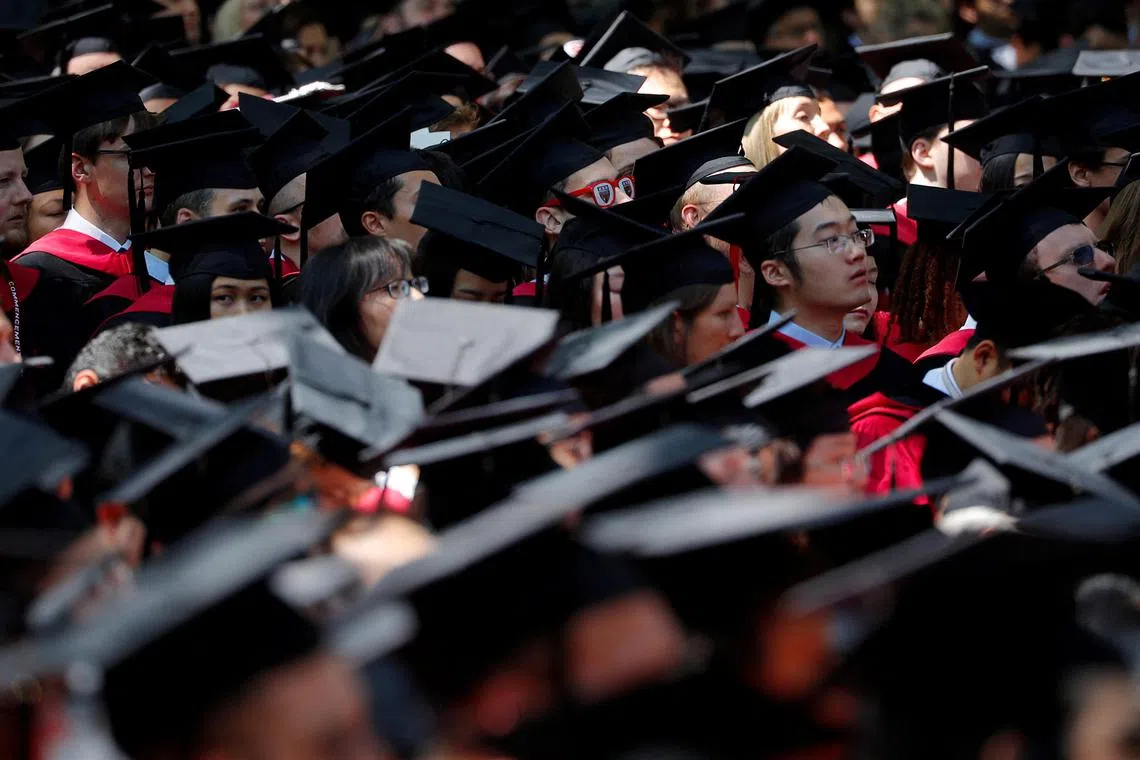US Supreme Court strikes down university race-conscious admissions policies
Sign up now: Get ST's newsletters delivered to your inbox

According to Harvard, around 40 per cent of US colleges and universities consider race in some fashion.
PHOTO: REUTERS
Follow topic:
WASHINGTON - The US Supreme Court on Thursday struck down race-conscious student admissions programmes currently used at Harvard University and the University of North Carolina (UNC).
It is a sharp setback to affirmative action policies often used to increase the number of Black, Hispanic and other under-represented minority groups on campuses.
The justices ruled in favour of a group called Students for Fair Admissions, founded by anti-affirmative action activist Edward Blum, in its appeal of lower court rulings upholding programmes used at the two prestigious schools to foster a diverse student population.
The decision, powered by the court’s conservative justices with the liberal justices in dissent, was 6-3 against the University of North Carolina and 6-2 against Harvard. Liberal Justice Ketanji Brown Jackson did not participate in the Harvard case.
The affirmative action cases represented the latest major rulings powered by the Supreme Court’s conservative majority.
The court in June 2022 overturned the 1973 Roe v. Wade decision that had legalised abortion nationwide
Chief Justice John Roberts, writing for the majority, said, “Harvard and UNC admissions programmes cannot be reconciled with the guarantees of the Equal Protection Clause,” referring to the US Constitution’s promise of equal protection under the law.
“At the same time,” Justice Roberts said, “as all parties agree, nothing in this opinion should be construed as prohibiting universities from considering an applicant’s discussion of how race affected his or her life, be it through discrimination, inspiration, or otherwise.”
Many institutions of higher education, corporations and military leaders have long backed affirmative action on campuses.
The move had been not simply to remedy racial inequity and exclusion in American life, but to ensure a talent pool that can bring a range of perspectives to the workplace and US armed forces ranks.
According to Harvard, around 40 per cent of US colleges and universities consider race in some fashion.
Harvard and UNC have said they use race as only one factor in a host of individualised evaluations for admission without quotas – permissible under previous Supreme Court precedents.
They said curbing its consideration would cause a significant drop in enrolment of students from under-represented groups.
Critics, who have tried to topple these policies for decades, argue these policies are themselves discriminatory.
Many US conservatives and Republican elected officials have argued that giving advantages to one race is unconstitutional, regardless of the motivation or circumstances.
Some have advanced the argument that remedial preferences are no longer needed because the US has moved beyond racist policies of the past such as segregation and is becoming increasingly diverse.
The dispute presented the Supreme Court’s conservative majority an opportunity to overturn its prior rulings allowing race-conscious admissions policies.
Mr Blum’s group in lawsuits filed in 2014 accused UNC of discriminating against white and Asian-American applicants, and Harvard of bias against Asian-American applicants.
Students for Fair Admissions alleged that the adoption by UNC, a public university, of an admissions policy that is not race-neutral, violates the guarantee to equal protection of the law under the US Constitution’s 14th Amendment.
The group contended Harvard, a private university, violated Title VI of a landmark federal law called the Civil Rights Act of 1964, which bars discrimination based on race, colour or national origin under any programme or activity receiving federal financial assistance.
Lower courts rejected the group’s claims.
That decision prompted appeals to the US Supreme Court, asking the justices to overturn a key precedent holding that colleges could consider race as one factor in the admissions process because of the compelling interest of creating a diverse student body.
Affirmative action has withstood Supreme Court scrutiny for decades, most recently in a 2016 ruling involving a white student, backed by Mr Blum, who sued the University of Texas after being rejected for admission.
The Supreme Court has shifted rightwards since 2016 and now includes three justices who dissented in the University of Texas case and three new appointees by former Republican president Donald Trump. REUTERS

